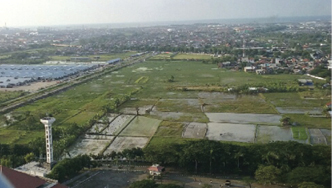
By Cory Fleming
Coastal communities are particularly susceptible to the impacts of climate change. Intense storms, beach erosion, and flooding are among the concerns faced by these communities.
Semarang (population 1.6 million) is a port city on the north coast of Java in Indonesia. The majority of the city's coastline is owned by private entities, which poses a challenge for the municipality in terms of protecting and regulating the coast.
Coping With Flood Damage
There are several key neighborhoods within the city that routinely experience intense flooding. In the eastern half of the city, the Tambaklorok neighborhood is privately owned by commercial interests; however, it is part of Semarang's harbor development plan.
In addition to warehouses and commercial loading docks, the neighborhood is home to considerable low-income housing. Also east of Semarang is the Trimulyo neighborhood, which is more residential in nature and subject to flooding as well.
Staff at the regional planning and development department Badan Perencana Pembangunan Daerah (BAPPEDA) believe that the land is subsiding in these neighborhoods, further contributing to frequent flooding. All disposable income in this area is used to protect homes from floods.
These areas have received a lot of local and national attention. The president of Indonesia has visited the area and made dealing with the flooding there a national mandate.
The Tapak neighborhood, west of Semarang, has also experienced notable flooding. This neighborhood is more rural in nature, consisting primarily of mangrove forests and commercial fishing ponds.
Safrinal Sofaniadi, who is an urban planner at BAPPEDA, notes that flooding and land subsidence are major concerns given the number of people who live in these neighborhoods.
"I cannot imagine how my people will be impacted at those locations. We need to scientifically document what is happening in these neighborhoods in order to decide how we can best protect them," Sofaniadi explained.
CityLinks Fosters Hope for Solutions
Sofaniadi led Semarang's effort to apply for ICMA's CityLinks Program. The program matches municipal officials in developing countries to U.S. cities and other ICMA members globally. In this case, Local Government Professionals Australia helped ICMA identify the city of Gold Coast, Australia, to partner with Semarang.
By matching the two cities together, the hope is to find sustainable solutions tailored to the real needs of cities. The CityLinks Program was first formalized in collaboration with the U.S. Agency for International Development.
"We applied to CityLinks because we can see the effects of climate change, but we don't have a lot of information on how to best manage our coastal areas. Do we, for example, need to build a greenbelt in Semarang? Is that the right program or not? We need to have the right information about what the government should do," explained Sofraniadi.
Gold Coast in Australia also is a coastal community that has dealt with coastal flooding and subsequently developed a robust coastal modeling program to support policy decisions for better coastal management.
Dr. Hamid Mirfenderesk, coordinator of natural hazards in Gold Coast's planning and environment department, serves as the primary contact for the city.
"We realize that Semarang was facing problems that our city might also have in the future," he observed. "Participating in CityLinks gives us an opportunity to learn from Semarang, as well as share our own knowledge on good coastal management practices."
Sharing Knowledge
With more than 30 years of experience in coastal modeling, Mirfenderesk recommended that Semarang work with its local Diponegoro University to establish a team of university students to work with professionals at BAPPEDA and develop a coastal model for Semarang.
Using tide, wave, and other available data, a coastal model will enable officials in BAPPEDA to better understand what underlying forces are at work causing the apparent land subsidence, coastal erosion, and other problems along the municipality's coastal areas.
Once Semarang officials understand what processes are at work, they can decide what action to take, such as dredging the river, building a seawall or jetty, relocating sand through a sea pump, or using other strategies for making the affected neighborhoods less susceptible to flooding.
"We have coastal modeling now that will help us to understand what we need to do," Sofaniadi said. "This project has [increased] my knowledge [about] other places that have had success managing their coast.
For his part, Mirfenderesk shared that, "The most important thing for me was the fighting spirit of the people of Semarang. I still remember one gentleman on our first visit telling us, "I'm standing on my land' as he planted mangroves in standing water.
"I believe Semarang will learn not how to fight nature, but how to stand its ground and understand how to counteract the transformation that climate change has brought to the city," he said.
When asked about next steps, Sofaniadi explained that developing a coastal model was the first step. The team of Diponegoro University students and BAPPEDA staff members will work to update the model and add additional data to it.
"I want it to do more," he said, "and I look forward to developing a coastal management program in Semarang like we saw in the Gold Coast."
New, Reduced Membership Dues
A new, reduced dues rate is available for CAOs/ACAOs, along with additional discounts for those in smaller communities, has been implemented. Learn more and be sure to join or renew today!
